Introduction
Onix is Mark Schifter's new company that markets speakers
built in China. It used to be Diva by Swans, but those are sold by someone
else now. Mark wanted his own brand, and here we are with the Onix.
China is coming on like a freight train building
speakers. The factory over there is huge, and they build them for lots of
companies, some tens of thousands of pairs each month.
The Onix are made only for Mark, and they are sold at his
website AV123.com.
We have received lots of questions about using front
radiating speakers vs. dipolar and bipolar speakers for the surrounds, and
these RSS-300s were so beautiful at Mark's website, I asked for a pair of them
to test and comment on, as to how they sound vs. front radiating speakers.
The Design
The Onix line has a number of models, including the
Rockets, of which the RSS-300s are a member. For $599 a pair, you get
enclosures that have rosewood veneer all the way around the front and sides,
and with black piano polymer tops and bottoms. There are two 5.25" aluminum
woofers (one on each side) and two 1" aluminum tweeters (one on each side).
The design is what's called adaptive dipole, meaning that one of the tweeters
is wired out of phase with the other three drivers.
The photo below shows that the driver pairs are at 750
to each other rather than back-to-back, which a classic dipole would be. These
two factors produce a diffuse sound that is different than a regular dipole,
but but does not have the large amount of cancellation front to back that the
regular dipole would have. You can also see in the photo how beautiful the
rosewood is, and because these speakers will likely be mounted on the wall
high up, the grilles can be left off without worrying about someone putting
their fingers into the drivers.
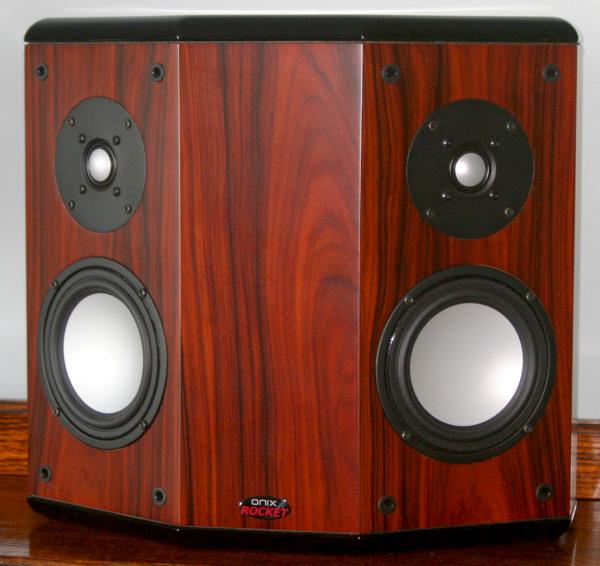
The rear panel is also rosewood, with a mounting
(hanging) bracket at the top, and a single pair of five-way speaker binding
posts at the bottom.

The Sound
These speakers are rather big and heavy, and I wanted to
just see how they sounded as a stereo pair, so I connected them to my reference
two-channel audio system. I was actually quite surprised at how natural they
were, although there was an expected attenuation of the bass. In any case, no boominess, no chestiness, no nasality, and no tizziness. I had seen some
remarks on newsgroups about how the Divas and Rockets might be a bit bright,
but it just did not happen. They are very smooth.
I mounted the RS-300s on the wall near the ceiling, to
the sides of my listening position and connected them into my Theta Casablanca
II setup as part of a 7.1 configuration.
The entire side wall suddenly was alive with sound now,
instead of having a hole that otherwise left the surround sound envelopment
incomplete. That is not to say 5.1 isn't satisfying, but the addition of two
speakers on the sides to compliment having speakers in the front and the rear
does really help.
I could not localize the sound at all on the sides with
these dipoles. In fact, I kept looking to the sides when I heard sounds there,
but never directly at the speakers. This compares with front radiating
speakers where I can localize the sound almost completely as to its
directionality.
For most of us who are just now getting set up for 7.1,
it means adding another stereo power amplifier to the pile of boxes. I used a
Sherbourn multi-channel power amplifier, with two 200 watt modules inside, to
drive the RSS-300s (a Rotel RMB-1095 five-channel power amp drove the other
speakers).
In retrospect, I think one could get by with much less power on the sides, as I
preferred the volume there at a reasonably low level. However, I did notice in
using the RSS-300s as a two-channel stereo setup, that I needed to turn the
volume control up more than with some of my other speakers, so I was very
interested to see how they tested on the bench (results shown below).
Although the side speakers are recommended to be dipoles
or bipoles, which these are, and to be mounted to the side of the listening
position, I found that I preferred these dipoles a little more to the front of
where I sit. It gave me a wider front soundstage, giving up a little of the
side envelopment, but that is what felt best to me. This is one of the nice
things about a home theater. You can put the stuff where it pleases you. So,
my preferences wouldn't make a THX certification, but it felt good, so I did
it. Perhaps later on, when I get used to more sound coming from the side
areas, I will move them back to where the recommended position would be.
On the Bench
At 50 Hz and 100 dB output measured from one of the
woofers, there was a lot of THD, which is to be expected. But at 100 Hz, the
THD went way down, which is what I wanted to see.
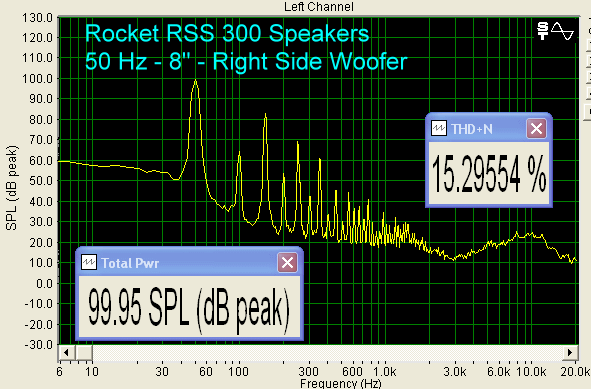

The RSS-300s cross over at 3.8 kHz, so at 1 kHz, the
sound is still coming from the woofers. However, distortion was still very
acceptable, compared to some larger drivers where they are expected to
reproduce the 1 kHz.
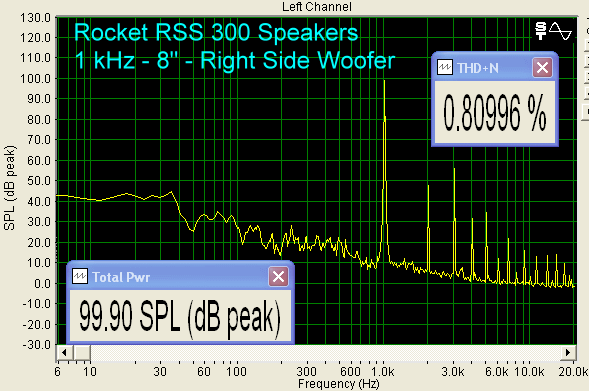
At 5 kHz, and measured from one of the tweeters, a nice
THD result.

IMD measurements, using 5 kHz and 6 kHz, produced a
little more distortion than some speakers we have tested, but still a
respectable figure.
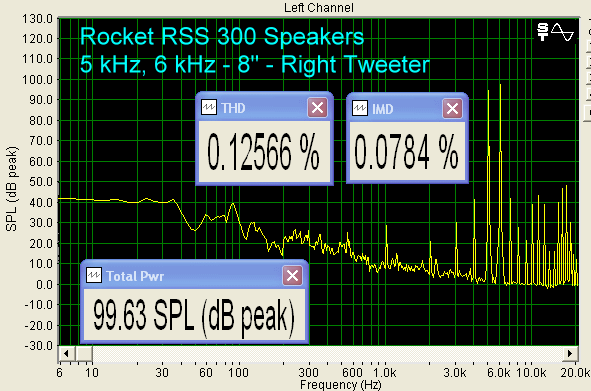
The measured frequency response was very interesting.
This first graph shows the response as measured directly in front, on-axis, so
that the two pairs of drivers were 370 to the sides. Notice that it
is reasonably flat, then drops off sharply above about 17 kHz.
The impulse response, shown magnified, is at the bottom
of the graphs. In the Front On-Axis impulse response, notice that there is a
significant time difference between the peaks, with the first negative one
being the tweeter and the second negative one being the woofer. This indicates
that the RSS-300 is not a time aligned design (not necessary in a speaker
designed to produce a diffuse sound field). In the second graph, Side
On-Axis (microphone measuring right side instead of the front), there are
multiple peaks, which are a result of the left side drivers being farther away
from the microphone than the right side drivers.
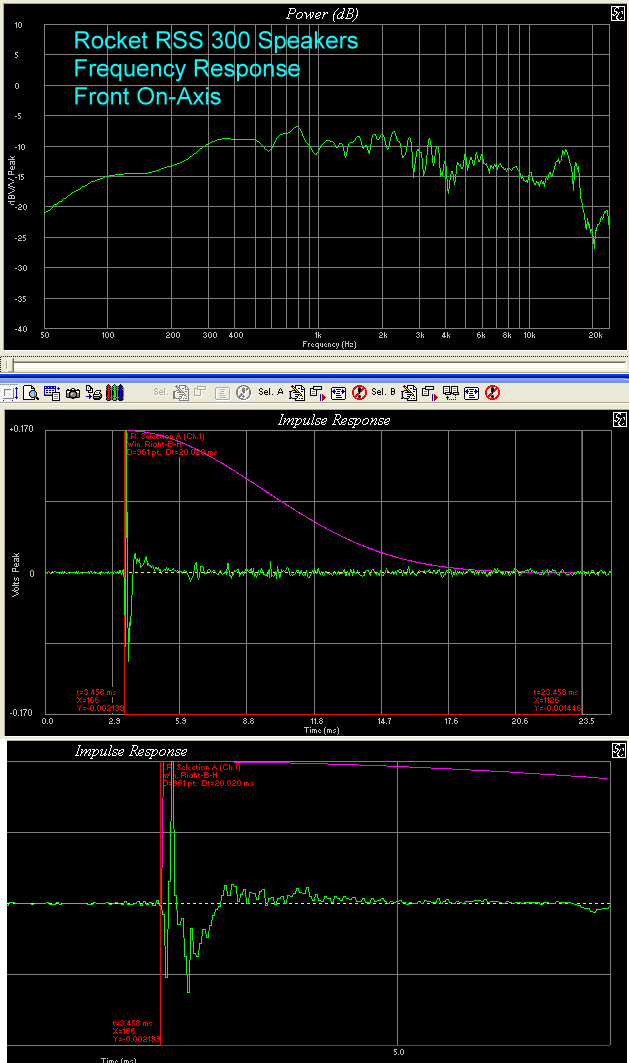
Now compare those results to the frequency response
on-axis with the right side set of drivers. It has distinct valleys at 1.2 kHz
and 3.2 kHz. Obviously, the RSS-300s have been optimized to produce the
flattest response off-axis to the drivers (directly to the front, where your
sitting position would be).
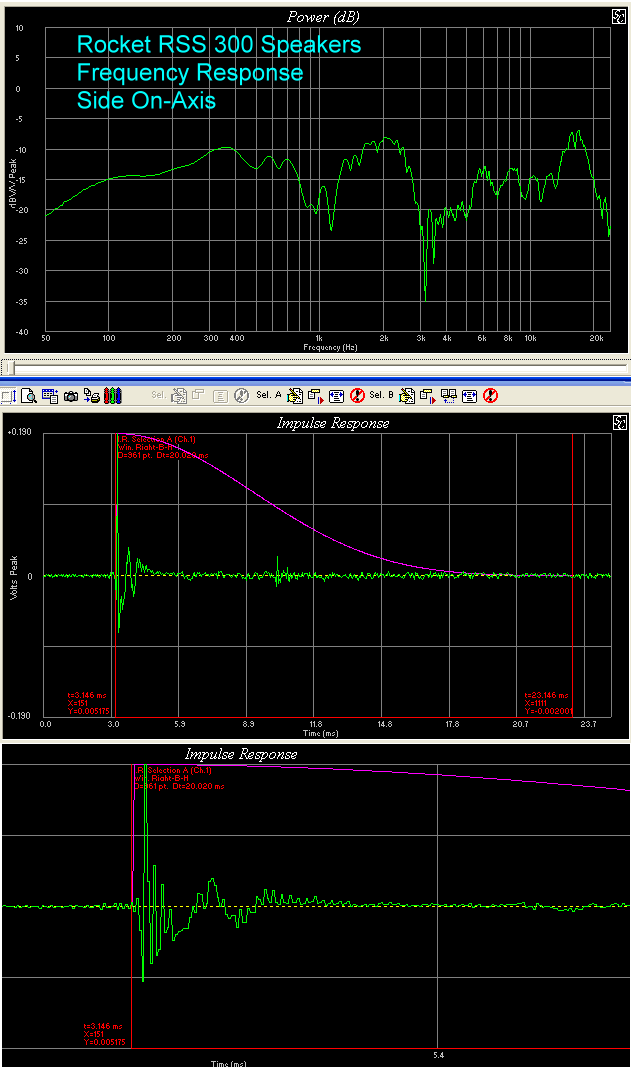
Although the RSS-300s are specified as having a nominal
impedance of 6 Ohms, the tests showed a much higher impedance of around 18
Ohms. The 80 Hz peak is the resonant frequency of the speaker. That is the
point in the frequency spectrum where the resistance to movement from the
moving mass equals the resistance from the suspension stiffness. Or, rather,
the equivalent inductance of the system equals the
equivalent capacitance.
The DC resistance was high, at 13 Ohms. This is why I needed a higher
volume setting on the amplifier. However, this is good, not bad. It means that
just about any mass market receiver there is will be able to drive these
without any problems of current drain due to low impedance. You will have to
turn up the volume setting perhaps, but the amplifier will consider them a
breeze.
You can see a few small notches up around 100 Hz, 175 Hz,
and 250 Hz, which could be due to enclosure resonances.
Electrical phase stayed well within ±
450, which is excellent.
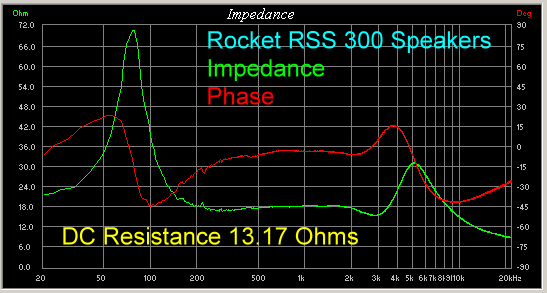
Conclusions
To answer all the Q&As we receive about using dipoles on
the sides, I would give a resounding YES. They produce a nice diffuse sound,
and I have to say that I like real diffuseness on the sides when I thought I
might not.
The Onix Rocket RSS-300s are very good speakers.
If I had not known their MSRP, looking at them and listening to them, I would
have thought they were more likely a > $1,000/pair speaker. Congratulations to
Mark Schifter and his Onix line. We wish him all the best.